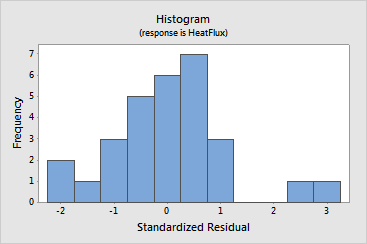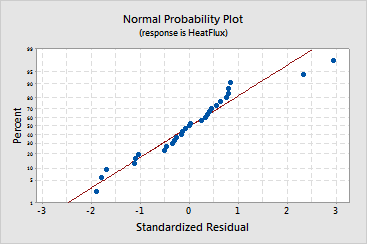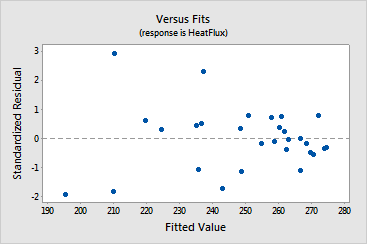As part of a test of solar energy, you measure the total heat flux from
homes. You wish to examine whether total heat flux (HeatFlux) can be predicted
by the position of the focal points in the east, south, and north directions.
Data are from [33]. You found,
using best
subsets regression, that the best two-predictor
model included the variables North and South and the best three-predictor
added the variable East. You evaluate the three-predictor model using
multiple regression.
1 Open the worksheet EXH_REGR.MTW.
2 Choose Stat
> Regression > Regression > Fit Regression Model.
3 In Responses, enter HeatFlux.
4 In Continuous predictors, enter East
South North.
5 Click
Graphs.
6 Under Residuals for Plots, choose Standardized.
7 Under
Residual Plots,
choose Individual Plots.
Check Histogram of residuals,
Normal probability plot
of the residuals, and Residuals
versus fits.
8 Click
OK in each dialog
box.
Session window output
|
Regression Analysis: HeatFlux versus East, South, North
Analysis of Variance
Source DF Adj SS Adj MS F-Value P-Value
Regression 3 12833.9 4278.0 57.87 0.000
East 1 226.3 226.3 3.06 0.092
South 1 2255.1 2255.1 30.51 0.000
North 1 12330.6 12330.6 166.80 0.000
Error 25 1848.1 73.9
Total 28 14681.9
Model Summary
S R-sq R-sq(adj) R-sq(pred)
8.59782 87.41% 85.90% 78.96%
Coefficients
Term Coef SE Coef T-Value P-Value VIF
Constant 389.2 66.1 5.89 0.000
East 2.12 1.21 1.75 0.092 1.12
South 5.318 0.963 5.52 0.000 1.21
North -24.13 1.87 -12.92 0.000 1.09
Regression Equation
HeatFlux = 389.2 + 2.12 East + 5.318 South - 24.13 North
Fits and Diagnostics for Unusual Observations
Std
Obs HeatFlux Fit Resid Resid
4 230.70 210.20 20.50 2.94 R
22 254.50 237.16 17.34 2.32 R
R Large residual
|



Interpreting the results
Session window output
· The
p-value
for the regression model in the Analysis of Variance table
(0.000) shows that the model estimated by the regression procedure is
significant
at an a-level
of 0.05. This indicates that at least one coefficient is different from
zero.
· The
p-values for the estimated coefficients
of North and South are both 0.000, indicating that they are significantly
related to HeatFlux. The p-value for East is 0.092, indicating that it
is not related to HeatFlux at an a-level
of 0.05. Additionally, the sequential sum of squares
indicates that the predictor East doesn't explain a substantial amount
of unique variance. This suggests that a model with only North and South
may be more appropriate.
· The
VIFs
are all close to 1, which indicates that the predictors are not correlated.
VIF values greater than 5-10 suggest that the regression coefficients
are poorly estimated due to severe multicollinearity.
· The
R2
value indicates that the predictors explain 87.41% of the variance in
HeatFlux. The adjusted R2
is 85.90%,
which accounts for the number of predictors in the model. Both values
indicate that the model fits the data well.
· The
predicted R2
value is 78.96%. Because the predicted R2
value is close to the R2
and
adjusted R2 values,
the model does not appear to be overfit and has adequate predictive ability.
· Observations
4 and 22 are identified as unusual because the absolute value of the standardized
residuals are greater than 2. This may indicate they are outliers.
See Checking your model,
Identifying
outliers, and Choosing a residual
type.
Graph window output
· The
histogram
indicates that outliers may exist in the data, shown by the two bars on
the far right side of the plot.
· The
normal probability plot
shows an approximately linear pattern consistent with a normal
distribution.
The two points in the upper-right corner of the plot may be outliers.
Brushing
the graph identifies these points as 4 and 22, the same points that
are labeled unusual observations in the output. See Checking
your model and Identifying outliers.
· The
plot of residuals
versus the fitted values
shows that the residuals
get smaller (closer to the reference line) as the fitted values increase,
which may indicate the residuals have non-constant variance. See [9]
for information on non-constant variance.


